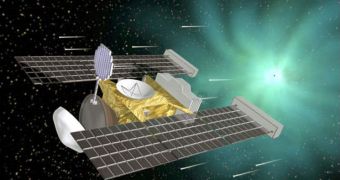A NASA statecraft is currently getting ready for a Valentine's Day visit to a comet making his way through the solar system. The probe, which is already at its third cometary flyby, has just finished adjusting its course, which will take it in the best possible angle to image its target.
It is heading for an icy comet called 9P/Tempel 1, which was already the target of the Deep Impact space probe in 2005. At that time, the NASA robot dropped an impactor on the surface of the body.
The American space agency hoped that this will reveal more clues about the inner composition of the comet, but the dust and ice plume that was generated following the collision made any subsequent attempts at imaging the crater futile.
Now, all these years later, things are certainly different, investigators say. The crater is bound to be visible with no problem. The new flyby will take the current NASA probe about 124 miles (200 kilometers) above the surface of the comet.
The Stardust-NExT mission is uniquely prepared for this task, having already carried out a sample-return flight to comet Wild 2, and another flyby of the comet Annefrank, Space reports.
After being launched, in February 1999, the Stardust mission managed to achieve its primary mission objective in 2006. Since it refused to succumb to the adverse conditions in which it's been operating for years, scientists at NASA though they should use it again.
The decision was made at the NASA Jet Propulsion Laboratory (JPL), in Pasadena, California. Experts at the Lab have been managing the mission since day one. They were the ones who saw that Stardust could reach Tempel 1 if it was programmed to do so.
Now, the mission has already snapped its first images of its target, which it's due to reach on February 14. The images were taken on January 1819 from distances of 16.3 million miles (26.3 million kilometers), and 15.8 million miles (25.4 million km).
“Encountering something as small and fast as a comet in the vastness of space is always a challenge, but we are very pleased with how things are setting up for our Valentine's Day flyby,” Cornell University researcher Joe Veverka said in a recent statement.
Course correction maneuvers had already been carried out, and so the flyby should go precisely as planned, if nothing else interferes with the mission.

 14 DAY TRIAL //
14 DAY TRIAL //